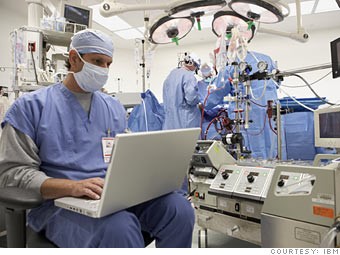
7 Digital Hospital Trends for 2014
In 1999, I had to source, negotiate, and implement an integrated monitoring system for ICU. This basic system networked bedside computers to a central nursing monitoring system and was considered innovative, effective and clever.
Fifteen years later, electronic medical files and data sharing between imaging modalities, laboratory tests, pharmacy prescription listings, and MSP formulary plans provide basic input to clinical decision making. Telemedicine is the norm and provides 24/7 supports to rural general practitioners.
What will medical technology look like in the next few years? What algorithm, data formatting, connectivity requirements and archiving capabilities are required for state-of-the-art medical technology? What will the future hospital look like and what are the trends in digital health? E-health will no doubt continue, and here are my previews of 7 Digital Hospital Trends to look for in 2014.
- Patient control: the patient will control the room environmental conditions using an iPad and be able to video link to communicate to a nurse. No more nurse call bell.
- Elimination of manual data entry: vital signs of blood pressure, temperature, O2 sat, respiratory rhythm, ECG or EEG outputs will all be automatically communicated to electronic medical charts.
- Significant reduction of paper: the final stage of e-health programs’ implementation will see printers become redundant. Electronic medical records in primary care physicians is the first visible sign that the wall of paper charts will soon completely disappear. Is your doctor still using paper?
- Virtual Health Services: original telemedicine and telehealth systems will slowly be replaced by social medical platform for simpler and cheaper systems. The iPad will have it all.
- Improved Connectivity: it was not long ago that centralization was the goal, but the new reality brings it back locally. Standalone systems connected to hospital data management systems will disseminate information outside the walls of the hospital to support near and far located practitioners. These mini integrated systems create a powerful network.
- Use of Data for Population Health: with the abundance of data, government effort is in a great position to focus on tracking disease propagation in populations, informing health care professionals of novel effective therapies, dissipating drug alert and adverse effects, etc.
- Less Invasive Procedures: Patients want speedy recoveries. Software engineers will need to continue developing smart systems to provide surgeons and interventionists with 3D visual representations of internal organs, and enable remote visual access to surgeons needing to participate in the procedure.
The integration of medical technologies not only support improved and cheaper health care, it provides the day-to-day information required for decision making in therapies and preventing programs. The key for software engineers and systems architects is to ensure that protocols remain standardized, data clean and communication effective. Despite technology being powerful, it remains a tool – and just a tool – needing consideration, analysis, and judgement involving the human mind. Medical professionals must keep abreast of technological advancements to keep their surgical skills and clinical relevance.
Martine Janicki leads the PMO at Starfish Medical and holds a PhD, PEng and a PMP certification. Please visit our Medical Product Development page for more information on how Project Management plays a key role at Starfish Medical.
Image Courtesy of IBM